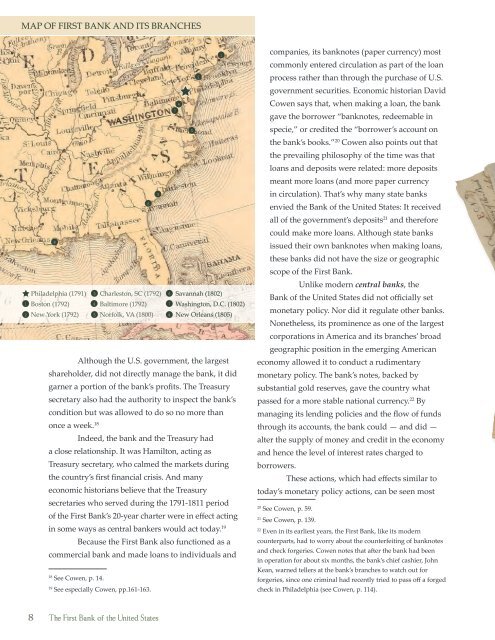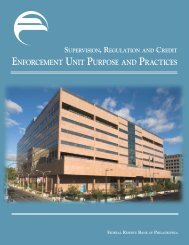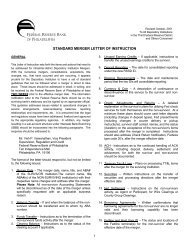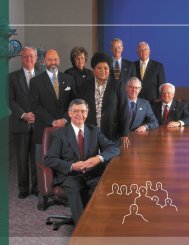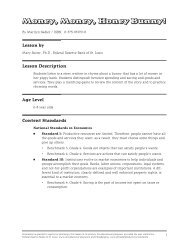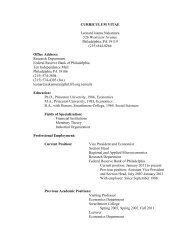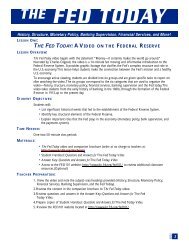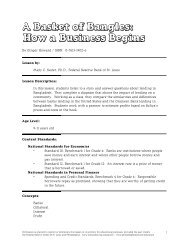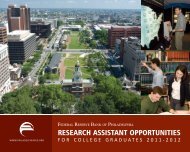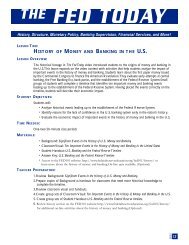The First Bank of the United States - Federal Reserve Bank of ...
The First Bank of the United States - Federal Reserve Bank of ...
The First Bank of the United States - Federal Reserve Bank of ...
Create successful ePaper yourself
Turn your PDF publications into a flip-book with our unique Google optimized e-Paper software.
MAP OF FIRST BANK AND ITS BRANCHES<br />
1<br />
2<br />
8<br />
8<br />
Philadelphia (1791)<br />
Boston (1792)<br />
New York (1792)<br />
3<br />
4<br />
5<br />
Charleston, SC (1792)<br />
Baltimore (1792)<br />
Norfolk, VA (1800)<br />
Although <strong>the</strong> U.S. government, <strong>the</strong> largest<br />
shareholder, did not directly manage <strong>the</strong> bank, it did<br />
garner a portion <strong>of</strong> <strong>the</strong> bank’s pr<strong>of</strong>its. <strong>The</strong> Treasury<br />
secretary also had <strong>the</strong> authority to inspect <strong>the</strong> bank’s<br />
condition but was allowed to do so no more than<br />
once a week. 18<br />
Indeed, <strong>the</strong> bank and <strong>the</strong> Treasury had<br />
a close relationship. It was Hamilton, acting as<br />
Treasury secretary, who calmed <strong>the</strong> markets during<br />
<strong>the</strong> country’s first financial crisis. And many<br />
economic historians believe that <strong>the</strong> Treasury<br />
secretaries who served during <strong>the</strong> 1791-1811 period<br />
<strong>of</strong> <strong>the</strong> <strong>First</strong> <strong>Bank</strong>’s 20-year charter were in effect acting<br />
in some ways as central bankers would act today. 19<br />
Because <strong>the</strong> <strong>First</strong> <strong>Bank</strong> also functioned as a<br />
commercial bank and made loans to individuals and<br />
18 See Cowen, p. 14.<br />
19 See especially Cowen, pp.161-163.<br />
<strong>The</strong> <strong>First</strong> <strong>Bank</strong> <strong>of</strong> <strong>the</strong> <strong>United</strong> <strong>States</strong><br />
6<br />
3<br />
6<br />
7<br />
8<br />
4<br />
7<br />
5<br />
2<br />
Savannah (1802)<br />
Washington, D.C. (1802)<br />
New Orleans (1805)<br />
1<br />
companies, its banknotes (paper currency) most<br />
commonly entered circulation as part <strong>of</strong> <strong>the</strong> loan<br />
process ra<strong>the</strong>r than through <strong>the</strong> purchase <strong>of</strong> U.S.<br />
government securities. Economic historian David<br />
Cowen says that, when making a loan, <strong>the</strong> bank<br />
gave <strong>the</strong> borrower “banknotes, redeemable in<br />
specie,” or credited <strong>the</strong> “borrower’s account on<br />
<strong>the</strong> bank’s books.” 20 Cowen also points out that<br />
<strong>the</strong> prevailing philosophy <strong>of</strong> <strong>the</strong> time was that<br />
loans and deposits were related: more deposits<br />
meant more loans (and more paper currency<br />
in circulation). That’s why many state banks<br />
envied <strong>the</strong> <strong>Bank</strong> <strong>of</strong> <strong>the</strong> <strong>United</strong> <strong>States</strong>: It received<br />
all <strong>of</strong> <strong>the</strong> government’s deposits21 and <strong>the</strong>refore<br />
could make more loans. Although state banks<br />
issued <strong>the</strong>ir own banknotes when making loans,<br />
<strong>the</strong>se banks did not have <strong>the</strong> size or geographic<br />
scope <strong>of</strong> <strong>the</strong> <strong>First</strong> <strong>Bank</strong>.<br />
Unlike modern central banks, <strong>the</strong><br />
<strong>Bank</strong> <strong>of</strong> <strong>the</strong> <strong>United</strong> <strong>States</strong> did not <strong>of</strong>ficially set<br />
monetary policy. Nor did it regulate o<strong>the</strong>r banks.<br />
None<strong>the</strong>less, its prominence as one <strong>of</strong> <strong>the</strong> largest<br />
corporations in America and its branches’ broad<br />
geographic position in <strong>the</strong> emerging American<br />
economy allowed it to conduct a rudimentary<br />
monetary policy. <strong>The</strong> bank’s notes, backed by<br />
substantial gold reserves, gave <strong>the</strong> country what<br />
passed for a more stable national currency. 22 By<br />
managing its lending policies and <strong>the</strong> flow <strong>of</strong> funds<br />
through its accounts, <strong>the</strong> bank could — and did —<br />
alter <strong>the</strong> supply <strong>of</strong> money and credit in <strong>the</strong> economy<br />
and hence <strong>the</strong> level <strong>of</strong> interest rates charged to<br />
borrowers.<br />
<strong>The</strong>se actions, which had effects similar to<br />
today’s monetary policy actions, can be seen most<br />
20 See Cowen, p. 59.<br />
21 See Cowen, p. 139.<br />
22 Even in its earliest years, <strong>the</strong> <strong>First</strong> <strong>Bank</strong>, like its modern<br />
counterparts, had to worry about <strong>the</strong> counterfeiting <strong>of</strong> banknotes<br />
and check forgeries. Cowen notes that after <strong>the</strong> bank had been<br />
in operation for about six months, <strong>the</strong> bank’s chief cashier, John<br />
Kean, warned tellers at <strong>the</strong> bank’s branches to watch out for<br />
forgeries, since one criminal had recently tried to pass <strong>of</strong>f a forged<br />
check in Philadelphia (see Cowen, p. 114).


